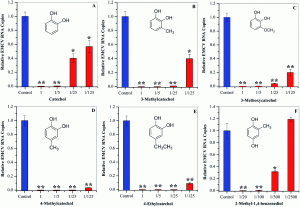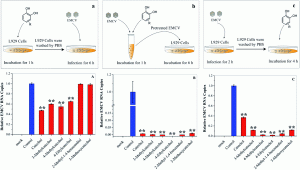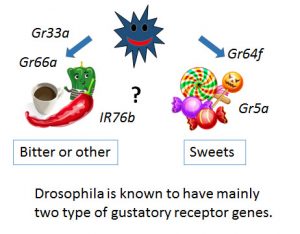2018 Activity Report for Mission 5-1: Harmonization of Human Health and the Environment
Updated: 2019/04/26
Research 1-1: Production of bioactive compounds from plant biomass
Principal Investigator (PI): Takashi Watanabe (RISH, Kyoto University)
Research collaborator(s): Hiroshi Nishimura, Ruibo Li, Chihiro Kimura, Tatsuya Miyazaki (RISH, Kyoto University), Ryota Ouda (Graduate School of Medicine, Hokkaido University), Ryo Narita, Takashi Fujita (Institute for Frontier Life and Medical Sciences, Kyoto University), Osamu Matsuda, Eriko Ohgitani, Rio Kashimoto (Graduate School of Medicine, Kyoto Prefectural University of Medicine)
Joint studies on antiviral compounds from wood and bamboo vinegars have been conducted, with the goal of contributing to human health and life by producing medicinal and biologically active substances from unutilized biomass. We also studied production of antiviral and antitumor compounds by chemical degradation of wood and sugarcane bagasse in collaboration with Institute for Frontier Life and Medical Sciences, Kyoto University and Kyoto Prefectural University of Medicine. In FY 2018, We revealed effects of substituents of catechol derivatives on the antiviral activity against EMCV. We also found that the inhibition is due to direct inactivation of virus by the catechol derivatives and published the results in an international journal. We also found that chemical degradation of wood and sugarcane produces antiviral and antitumor compounds and analyzed structures of the bioactive compounds.
Antiviral activities of catechol derivatives from wood vinegar against EMCV and the host cell, L9291
*P < 0.05, **P < 0.01 indicate a significant difference compared to the solvent control by student’s t-test.
Publications, etc.
- R .Li, R. Narita, R. Ouda, C. Kimura ,H. Nishimura, M. Yatagai, T. Fujita, T. Watanabe, Structure-dependent antiviral activity of catechol derivatives in pyroligneous acid against the encephalomycarditis virus. RSC Adv., 2018, 8,35888-35896. (2018). DOI: 10.1039/C8RA07096B
- Kimura, R. Li, R. Ouda, H. Nishimura, T. Fujita, T. Watanabe, Production of antiviral compounds from sugarcane bagasse by microwave reactions, 2018 Joint Convention SWST & JWRS, Nagoya (5-9/11, 2018).
Research 1-2: Production mechanism of bioactive compounds and biotechnology (Kazufumi Yazaki)
Principal Investigator (PI): Kazufumi Yazaki (RISH, Kyoto University)
Research collaborator(s): Akifumi Sugiyama (RISH, Kyoto University), Taku Tsuyama (Faculty of Agriculture, Miyazaki University), Futoshi Taura (Toyama University Graduate School of Pharmaceutical Sciences)
Many plant secondary metabolites utilized in clinical fields have strong lipophilic properties, e.g., vincristine and paclitaxel serving as anti-cancer drugs, while their secretion mechanism from the cells are largely unknown. In this study, we are attempting to elucidate the molecular mechanism of lipid secretion from plant cells, utilizing shikonin producing system as a model.
In 2018, we have conducted biochemical and molecular biological analyses based on the following model for the secretion of lipophilic metabolites from Lithospermum erythrorhizon cells, which are capable of producing a large amount of shikonin derivatives (10% of cell dry weight). This year we were invited several meetings, including the 23rd international symposium on plant lipid (ISPL 2018), where our recent results were presented followed by active discussion about the still largely unknown lipid secretion mechanisms in plants. In addition, as a collaboration with Dr. F. Taura of Toyama University, we published a unique farnesyltransferase involved in the formation of daurichromenic acid, a lipophilic anti-HIV compound produced by a bush, Rhododendron dauricum. Furthermore, we have developed a genome editing system to characterize a serious of candidate clones narrowed down thus far.
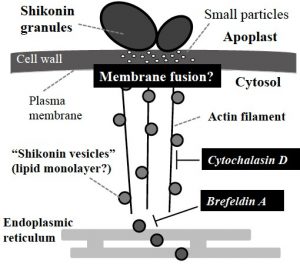
Publications, etc.
- Saeki, H., Hara, R., Takahashi, H., Iijima, M., Munakata, R., Kenmoku, H., Fuku, K., Sekihara, A., Yasuno, Y., Shinada, T., Ueda, D., Nishi, T., Sato, T., Asakawa, Y., Kurosaki, F., Yazaki, K., Taura F., A novel aromatic farnesyltransferase functions in the biosynthetic pathway of daurichromenic acid, Plant Physiol., 178: 535-551 (2018).
- Kusano, H., Ohnuma, M., Mutsuro-Aoki, H., Asahi, T., Ichinosawa, D., Onodera, H., Asano, K., Noda, T., Horie, T., Fukumoto, K., Kihira, M., Teramura, H., Yazaki, K., Umemoto, N., Muranaka, T., Shimada, H., Establishment of a modified CRISPR/Cas9 system with increased mutagenesis frequency using the translational enhancer dMac3 and multiple guide RNAs in potato, Sci. Rep., 8 (1), 13753 (2018).
- Yazaki, K., Shikonin production of Lithospermum erythrorhizon, a model system of secondary metabolic lipids in plants、The 23rd International Symposium on Plant Lipids (Yokohama), July 9th, 2018, Invited Lecture
- Yazaki, K., Biological event relevant for apoplastic accumulation of lipophilic metabolites, 36rd Japanese Society of Plant Cell and Molecular Biology (Kanazawa), 26th – 28th August, 2018, Invited lecture.
- Yazaki, K., Specific smart cells of plants and the controlling strategy, The 2nd Seminar of Smart Cell Forum 2018 in Kansai (Osaka), 14th November, 2018, Invited lecture.
Research 1-3: Establishment of unit reaction for biological production of antitumor lignans
Principal Investigator (PI): Toshiaki Umezawa (RISH, Kyoto University)
Research collaborator(s): Keisuke Kobayashi, Yu Matsuura, Masaomi Yamamura, Shiro Suzuki, Yuki Tobimatsu (RISH, Kyoto University)
Lignan is a class of phenylpropanoid dimers liked via C8-C8′ side chains of two phenylpropane units. Lignan has various biological activities. Among them, podophyllotoxin is an anti-tumor lignan and establishment of a stable biolotechnological production systems of the lignan is desired. In this study, we have attempted to clone cDNAs encoding enzymes involved in the antitumor lignan biosynthesis and to characterize the enzymes. Eight genes of lignan O-methyltransferases (OMTs) that catalyze the O-methylation in the lignan biosynthetic pathway have so far been isolated from several plants. Previously, we concluded that these OMTs were probably acquired by convergent evolution, because they are not highly homologous in terms of full-length amino acid sequences. In this fiscal year, we suggested that the existence of amino acid residues characteristic of lignan OMT.
Publication
- Kobayashi K, Yamamura M, Shiraishi A, Ono E, Ragamustari SK, Kumatani M, Satake H, Umezawa T, The 36th Annual Meeting of the Japanese Society of Plant Cell and Molecular Biology, Kanazawa, August 26-28, 2018 (Oral)
Research 1-4: Insect model to discover physiologically active substances in biomass (plants and microorganisms) – searching for gene resources though grooming behavior –
Principal Investigator (PI): Aya Yanagawa (RISH, Kyoto University)
Research collaborator(s): Coby Schal (North Carolina State University), Trudy Mackay (Clemson University), Wen Huang (Michigan University), Akihiko Yqmamoto (North Carolina University), Ayako Katsumata(North Carolina State University), Antoine Couto (CNRS), Jean-Chritophe Sandoz (CNRS), Toshimitsu Hata (Kyoto University), Aniruddha Mitra (Shoolini University), Mutaz Ali Agha(Ynsect), Frederic Marion-Poll(AgroParisTech, CNRS)
Animals groom themselves or each other. It appears, for example, that leg shaking in humans is a grooming behavior. Hence, the factors involved in grooming regard important to abnormal behaviors from stress or cardiac disorders. We would like to contribute medical treatments that can ease abnormal behaviors by clarifying the genes or chemical factors involved in grooming using an insect model. In 2018, to learn more about the gustatory genes serving to perceive Escherichia coli, we examined grooming responses to the application of lipopolysaccharide (LPS) from E.coli, caffeine, salts and sucrose on wing taste sensilla. Our results indicated that the grooming reflex induced by LPS requires gustatory cells related to bitter perception (Gr66a, Gr33a) as well as genes related to sweet and salt modalities (Gr5a, Gr64f and IR76b). It suggest that commercial LPS contains the gustatory cues perceived not only as aversive but also as sweet and salty by Drosophila
Publications, etc.
- Karim, M.R., Yanagawa, A., Ohinata, K., (2018) Soy undecapeptide induces Drosophila hind leg grooming via dopamine receptor, Biochem Biophys Res Commun. 499 (3), 454-458, doi: 10.1016/j.bbrc.2018.03.162.
- Yanagawa, A., Couto, A., Sandoz, JC., Hata, T., Mitra, A., Agha, M.A., Marion-Poll, F.,(2019) LPS perception through taste-induced reflex in Drosophila melanogaster, Journal of Insect Physiology 112, 39-47.
- Yanagawa, A., Neyen, C., Hata, T., Yoshimura, T., Lemaitre, B., Marion-Poll, F., Collaboration may exist between immunity and behavioral resistance in Drosophila, The 40th annual meeting of the Japanese Society for Comparative Physiology and Biochemistry (Poster presentation: November 2018, Kobe Japan).
- Mishima Kaiun Memorial Foundation 2018 research grants for natural science (Research Grant: 2018, June – 2019 May)
Research 1-5: Identification of transporters for bioactive compounds and their application for production
Principal Investigator (PI): Akifumi Sugiyama (RISH, Kyoto University)
Research collaborator(s): Shinjiro Ogita (Prefectural University of Hiroshima.), Nobukazu Shitan (Kobe Pharmaceutical University)
Purine permease(PUP) have been suggested to be involved in the uptake of caffeine in Arabidopsis and rice, although these plants do not contain caffeine. We have analyzed PUPs in Coffea canephora. We have identified 15 PUP members in the genome of C. canephora. Based on the expression analysis, we characterized caffeine uptake activity using yeast. Several members of CcPUPs were sensitive to caffeine, suggesting the involvement of these PUPs in caffeine uptake.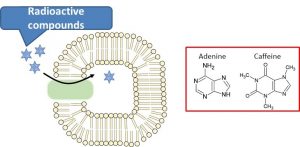
Publication
- Hirofumi Kakegawa、Nobukazu Shitan、Shinjiro Ogita、Kazufumi Yazaki、Akifumi Sugiyama “Expression and transport analysis of purine permeases of Coffea canephora. The 36th Annual meeting of the Japanese Society for Plant Cell and Molecular Biology Aug. 2018
Research 2:Biological effects of electromagnetic fields
Principal Investigator (PI): Junji Miyakoshi and Naoki Shinohara (RISH, Kyoto University)
There exists a wide variety of non-ionizing radiation (electromagnetic fields, EMF) in human living environments. There is increasing international discussion about the health risks of EMF exposure. We performed a risk assessment of EMF exposure using cellular and genetic examinations.
・Biological safety assessment of environmental EMF (millimeter waves, terahertz frequencies) fields.
・Biological safety assessment of EMF from wireless power transfer systems in human living environments.
We performed experiments to investigate what kind of influence was seen in living human body by electromagnetic waves used for Wireless Power Transmission (WPT) system. For this purpose, human corneal epithelial (HCE-T) cell was used for 400 kHz exposure experiments making consideration the depth from the living body surface. Micronucleus (MN) formation test and comet assay (DNA strand break) analysis as evaluation indices of genotoxicity, and heat shock protein (Hsp) expression test as one index for evaluating the physiological influences were performed.
A significant increase of MN formation was observed in HCE-T cell exposed by 400 kHz at 160 A/m (double power of 80 A/m as the ICNIRP occupational guidelines) for 1 hour. Although, no gain in tail moment as an index for DNA strand break was observed. An increase in expression of heat shock protein, Hsp-70, by the exposure was not observed, either. Consequently, it is thought that influence on expression induction of stress protein by the exposure to 400 kHz in HCE-T cell may be no-exist or extremely low, although a possibility of genotoxicity to have an influence on an increased frequency in MN formation was seen.
From this experiment, although there was no DNA strand break or no change of the protein expression induction in HCE-T cell exposed by 400 kHz. a possibility to have an influence on MN formation was only observed. We are going to push forward a study about biological effect of electromagnetic fields in future, particularly on immune response using keratinocyte cells derived from human skin epidermis.
Publications, etc.
- Junji Miyakoshi, Cellular Effects of Radio Frequency, Millimeter, and Terahertz Waves; in “Biological and Medical Aspects of Electromagnetic Fields, Fourth Edition” (eds. Ben Greenebaum and Frank Barnes), The Handbook of Biological Effects of Electromagnetic Fields, CRC Press (Taylor & Francis Group) London, pp 69-88. (2019)
- J. Miyakoshi, H. Tonomura, S. Koyama, E. Narita, N. Shinohara, Effects of exposure to 5.8 GHz electromagnetic field on micronucleus formation, DNA strand breaks, and heat shock protein expressions in cells derived from Human eye. IEEE Xplore, Engineering in Medicine and Biology Society (in Press).
Research 3: Air quality issues in outdoor and indoor environments
Principal Investigator (PI): K. Takahashi and M. Yabuki (RISH, Kyoto University)
Human activities increasingly influence the Earth’s climate and ecosystems. For instance, humans change the atmospheric aerosol loadings by emitting primary aerosol particles and a variety of trace gases that could be chemically transformed to give aerosol particles. Aerosol particles impact the Earth’s climate on a regional and global scale. Our study aims to develop in-situ and remote sensing techniques for observing trace gases and aerosol particles and their applications to outdoor and indoor measurements, which is closely linked to air quality issues in outdoor and indoor environments. In FY2018, we developed a new high-range resolution lidar for aerosol measurements and started a continuous observation of urban air pollution by laser absorption spectroscopy.
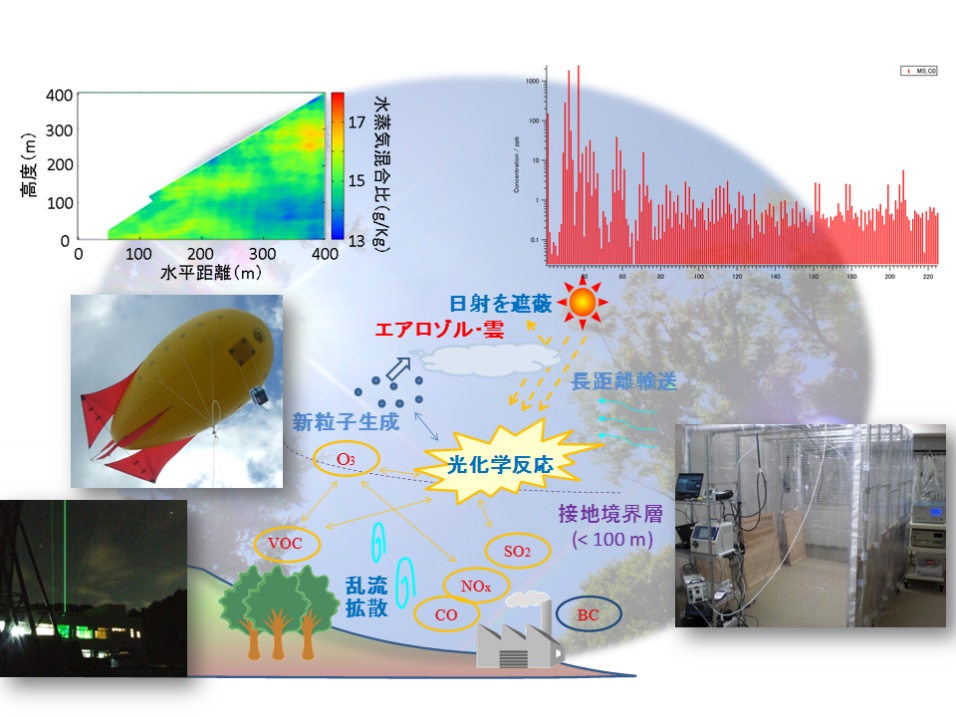
Development of new techniques for exploring spatio-temporal variations of atmospheric trace molecules and aerosol particles in outdoor and indoor environments.
Publications
- Takahashi, Application of laser spectroscopy techniques to atmospheric chemistry studies in a forest environment, International conference on tropical meteorology and atmospheric sciences (ICTMAS), Institut Teknologi Bandung, Indonesia, 2018.9.19-20.


